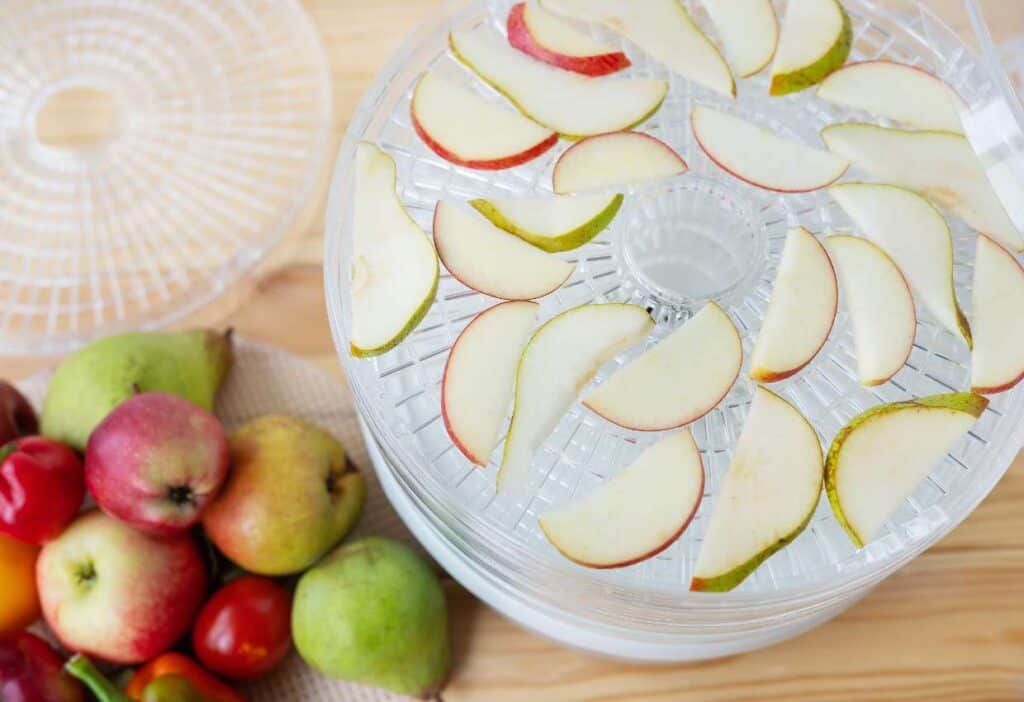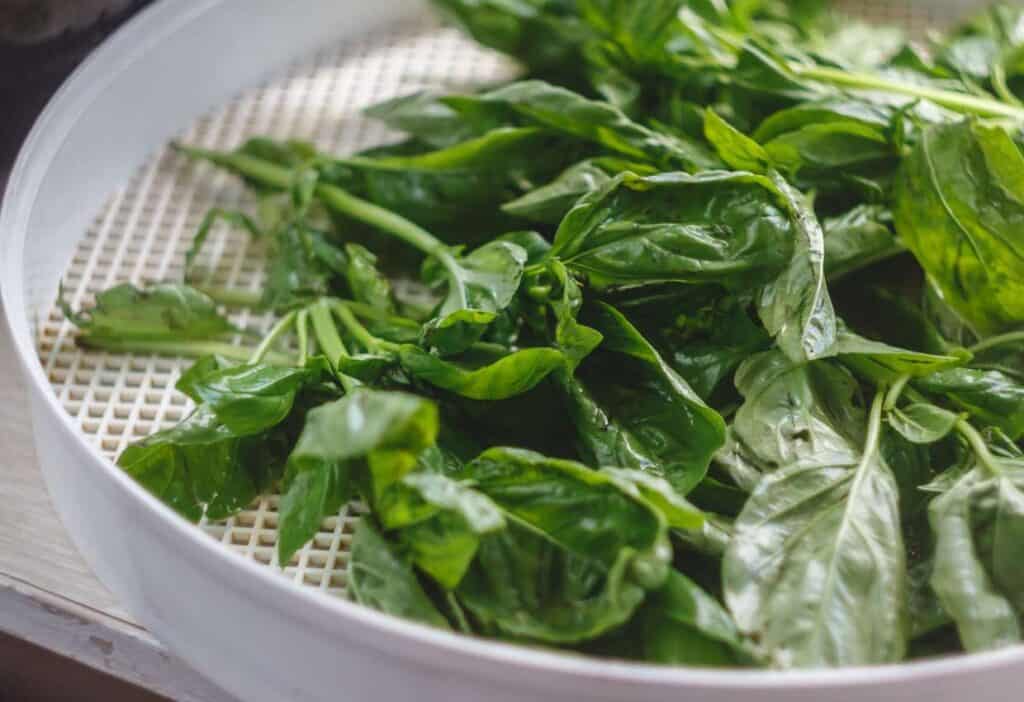Curious about dehydration for food preservation? Whether you’re a beginner or seeking new ideas, here’s a brief guide to the 10 best foods to dehydrate, plus tips to help you save time and money.

This post may contain affiliate link(s). As an Amazon Associate, I earn from qualifying purchases. See Disclosures.
Dehydrating foods extends their shelf life and also enhances their flavors and convenience. It is perfect for making the most of your garden harvest or creating healthy snacks.
10 best foods to dehydrate for beginners
Dehydrating foods is easy. Start with these 10 best foods to dehydrate for beginners.
- Apples: Slice thinly, treat with lemon juice to prevent oxidation and browning, then dehydrate for a sweet, chewy snack.
- Bananas: Cut into coins, optionally pretreat and dry for a portable treat.
- Strawberries: Halve or slice, add sugar if desired for extra sweetness and dehydrate into delicious treats.
- Tomatoes: Halve and season for a savory snack or salad addition.
- Onions: Slice, dehydrate and then store onions for cooking or as a crispy topping.
- Carrots: Thinly slice, blanch to soften and dry for soups and stews.
- Potatoes: Ideal for making chips or for adding to dishes once rehydrated. They are a great addition to your camping kitchen box.
- Mushrooms: Enhance their umami flavor by drying.
- Herbs: Dry at low temperatures to maintain flavor and aroma.
- Meat: Turn beef, chicken or turkey into jerky, a protein-rich snack.
Besides washing and slicing, these foods require very little prep work before dehydration. Get the family to work with younger children washing fruit and vegetables while older children chop and slice.
Food dehydration basics

Dehydration reduces the moisture content in foods, inhibiting the growth of bacteria and extending their life, turning them into long shelf-life foods. This technique turns ordinary ingredients into delicious, long-lasting treats. Whether you’re a seasoned dehydrator looking for new ideas or a novice curious about the process, understanding the basics is the first step.
Benefits of dehydrating foods
Drying or dehydrating various foods has been around for centuries. Dehydrating food offers multiple benefits.
- Preservation: Properly dehydrated foods can last months to a year.
- Flavor enhancement: Concentrates the natural flavors of foods.
- Reduction in size and weight: Makes storage and transportation easier.
- Nutrient retention: Maintains most of the nutrients, making it superior to other preservation methods.
- Cost-effective: Reduces food waste and can be cheaper than buying pre-packaged dried goods.
Choosing and preparing foods
Select fresh and ripe produce at the peak of its season for the best results when dehydrating foods. Avoid overripe, bruised or decaying fruits or vegetables. Proper preparation of food is crucial.
Wash all produce thoroughly to remove residues and contaminants. Uniform slices are essential for even drying, so cut or slice carefully. Use a mandolin slicer for consistent thickness.
Certain foods, like apples and bananas, may need pretreatment to avoid browning. To prevent browning, use lemon juice or ascorbic acid.
Dehydrating equipment
A food dehydrator is ideal because it has built-in features to regulate temperature and airflow. However, an oven can also serve as an alternative.
Food dehydrators
Food dehydrators have fans and heating elements that dry food evenly and efficiently. Various models are available in hardware and kitchen supply stores or online.
Some dehydrator models are simple, with just a few racks and a basic heat dial. Other models are larger, with more racks to accommodate more food and more precise temperature settings.
“I love dehydrating chili peppers because it’s the perfect way to save a big harvest. You can rehydrate peppers in soups and stews or grind them into flakes and powders to make delicious seasonings. Best of all, dehydrated peppers keep all their heat and delicious flavor.”
— Jenny TB, Grow Hot Peppers
Traditional electric or gas ovens
Set your oven to a low temperature, usually around 140 F, and keep the door slightly open to allow moisture to escape. This method requires more attention to ensure food dries evenly.
Solar dehydrating
Long before cooks used dehydrators or ovens to dehydrate food, they used the power of the sun. They dried fish outdoors on racks or dried berries on rocks in the sun. Whatever dehydration method you choose, you’ll require a heat source with constant low heat.
The dehydrating process

Temperature control is vital in dehydrating. Dehydrate foods at high temperatures to expel moisture quickly. However, avoid setting the temperature high enough to cook the food. Each type of food has specific temperature needs.
Fruits and vegetables typically require a temperature of 135 F. On the other hand, dehydrating wild game meat and fish requires higher temperatures, around 160 F, to ensure safety.
“We absolutely love dehydrated mango slices. They’re naturally sweet and make for a tasty snack on busy days or to take with us when camping. Plus, with a chewy texture, the kids can’t gobble them all up at once.”
— Shelby, Fit as a Mama Bear
Storing dehydrated foods
After dehydration, let the food cool completely before packaging to avoid condensation, which could lead to spoilage. Store your dehydrated food in eco-friendly, airtight containers, such as mason jars or vacuum-sealed bags.
Mark storage containers with the content type and date of dehydration. Then, store the jars in a cool, dark, dry place such as a pantry to maximize longevity.
Common food dehydration mistakes and how to avoid them
Food dehydration requires time, money and effort to grow, harvest, buy, prep and then dehydrate food. Protect your investment by avoiding these common mistakes.
- Improper preparation: Always use the freshest ingredients, clean them and then cut or chop them uniformly.
- Incorrect temperature: Follow specific temperature guidelines to prevent bacteria growth or over-drying.
- Overcrowding: Ensure ample space between pieces to allow for adequate air circulation.
You may first need to experiment with temperature, food placement and preparation. These things depend on what food you dehydrate and the method used.
Dehydrating food is an easy and enjoyable way to preserve food, enhance flavors and prepare for various needs, such as camping and building long-term food supplies for emergencies. Whether you prefer a food dehydrator, oven or just the sun, try this preservation technique to make the most of your food supplies today.
Sarita Harbour is a homeschooling, homesteading mom and a long-time business and finance writer. She created An Off Grid Life to help people become more self-reliant. Sarita and her family live off the grid in Canada’s Northwest Territories.